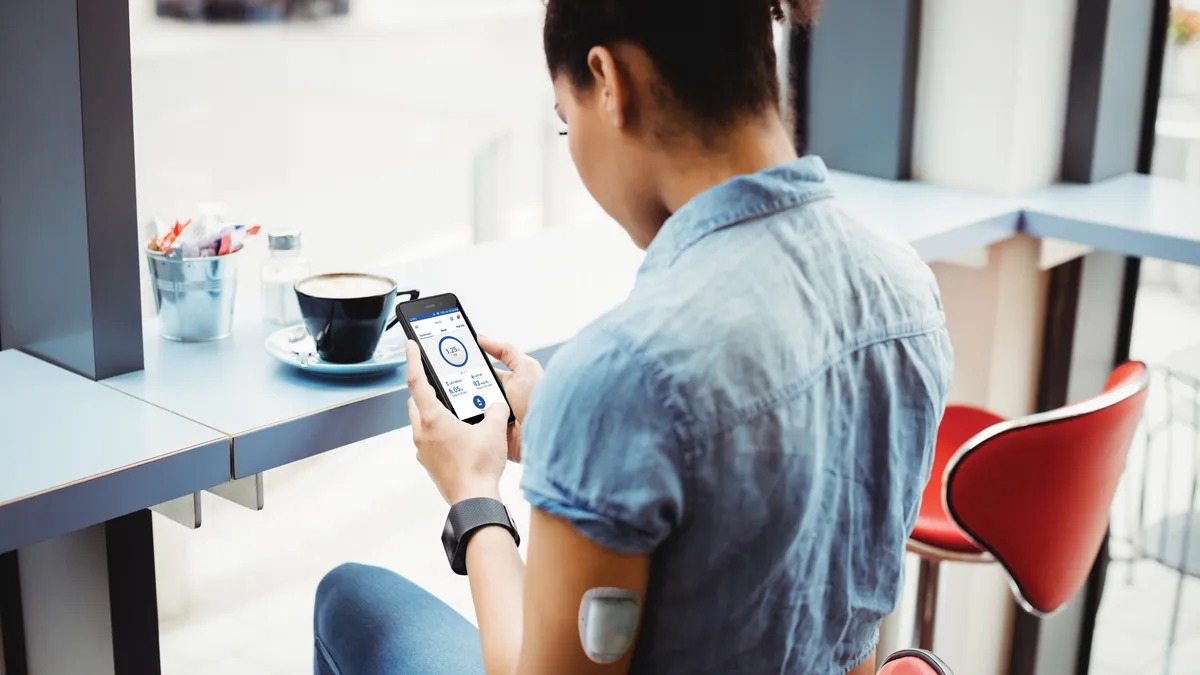The coronavirus pandemic has spurred an explosion in telehealth and digital health as patients stayed out of hospitals and doctors' offices to slow the spread of the virus turned to virtual care.
As a result, the healthcare landscape has significantly changed over the last 10-11 months and companies are making moves to capitalize on the rise of tech-driven services and wearable devices.
Patients embraced devices like continuous glucose monitors and insulin pumps in recent years before the pandemic, and companies in these markets like Dexcom and Insulet or Medtronic and Abbott Laboratories have remained successful despite the economic volatility throughout 2020.
Now, Wall Street and industry see 2021 as a watershed moment for diabetes technology. Along with plans to expand into new markets, nearly every major player in the CGM and insulin pump space have product launches this year, one of which J.P. Morgan said could be the year's biggest for industry.
As the CGM and insulin pump markets gain momentum, companies like Dexcom and Insulet point to a large, under-penetrated patient population as the largest growth opportunity.
In 2018, about 34 million people in the U.S. had diabetes, or 10.5% of the population, and another approximately 88 million adults were estimated to be pre-diabetic, according to a 2020 report from the Centers for Disease Control and Prevention. Nearly 8 million more were estimated to have diabetes but were not diagnosed.
The World Health Organization estimates that there are about 422 million people with diabetes across the globe. Much like other chronic illnesses, these numbers are expected to grow as the global population ages.
As both patients and providers rely more and more on virtual care, digitally-based diabetes management stands to gain further momentum.
Turning to tech
Traditionally, diabetes is managed with finger sticks to read blood glucose levels and insulin injections for patients who require them. But newer wearable devices like CGMs and insulin pumps are changing the diabetes market.
CGMs can automatically monitor blood glucose levels throughout the day and warn users when levels get too high or too low, and pumps can deliver insulin to patients without requiring the patient to administer an injection or multiple injections throughout the day.
Insulet CEO Shacey Petrovic contends the industry is at an "inflection point," where the tech has evolved and improved as patients have further embraced virtually-based services.
Because traditional pumps are more expensive and cumbersome, patients are not as willing to use them, according to Petrovic. The CEO said that recent smaller wearable pumps that have similar health outcomes to traditional care have helped fuel the change in patient behavior.
Because of this shift, the CEO does not view Insulet as competing in a defined insulin pump market but creating a market that may have not been there because the majority of users are dependent on injections, not pumps. Approximately 80% of the company's users are patients that inject insulin multiple times a day.
Petrovic said that the company has doubled its patient population to hundreds of thousands over the last five years.
Jake Leach, Dexcom's chief technology officer, outlined a similar story that fueled the company's success in recent years — the technology improved, costs dropped, and patients became more willing to use CGMs.
Petrovic and Leach said that while patient behavior was changing before the pandemic, the recent rise of virtual care has boosted CGM and pump adoption.
Both companies have remained successful in 2020 as others were harder hit by the pandemic. Dexcom's stock price increased from $238.54 to $366.89 over the last 12 months, and Insulet's grew from $193.51 to $275.03. Petrovic said during a November earnings call that Insulet should beat pre-pandemic expectations in 2020.
2021 product launches
The next step for diabetes care is connecting the CGMs and insulin pumps together through what is called a closed-loop system, which requires less direct involvement for patients in managing their diabetes. An algorithm, which companies have developed independently or license with partners, connects the devices and allows them to work together.
Tandem's Control-IQ technology was the first FDA-cleared algorithm for use with a fully interoperable, automated insulin dosing system. However, competitors in the space are now catching up.
Insulet has developed an algorithm of its own and will use it with its Omnipod 5 automated insulin pump to connect with CGMs like Dexcom's G6 system. Petrovic said that the company plans to receive FDA approval and launch the product in the first half of 2021.
To further ease of use for patients, the pump will transmit data to an application on patients' cell phones. Petrovic said that the product will be available first with Androids when launched and then, ultimately, iPhones.
J.P. Morgan analysts wrote that this product is one of the company's most important launches and one of the biggest for medtech this year. The pump may provide patients with a better option to Tandem's because it is tubeless and comes at a cheaper cost as it will be offered directly through a pharmacy as opposed to the durable medical equipment (DME) channel.
Meanwhile, after pushing back the product launch in 2020, Dexcom plans to launch its G7 CGM system at the end of 2021 with a further rollout in 2022, according to Leach. The product will be key for the company to hit its projection of doubling revenue by 2025.
Leach said that closed-loop systems are where the market is headed, and while it won't be needed by everyone with diabetes, about 50% of Dexcom's users will eventually be on the system.
Competing with medtech leaders
Analysts have been high on both Insulet and Dexcom, with J.P. Morgan analysts picking Insulet as a top small-cap company in a 2021 outlook and William Blair analysts writing that Dexcom should meet or beat expectations going forward.
Both, however, have to compete in a market with larger medtechs like Medtronic and Abbott.
Abbott's FreeStyle Libre CGM system has been a continual bright spot for the company and remained successful last year. CEO Robert Ford said during a fourth-quarter earnings call that FreeStyle Libre sales grew 50% in the U.S. in 2020 and 40% outside of the U.S., with international sales alone eclipsing $2 billion.
For comparison, Dexcom CEO Kevin Sayer projected during the J.P. Morgan healthcare conference that 2021 revenue will land in a range between $2.21 billion to $2.31 billion, representing growth of 15-20%.
Medtronic, the only company in the space to own both a CGM and insulin pump, has also recently re-prioritized its diabetes portfolio and invested in the more tech-driven management approach.
In June, the company received a $337 million investment from the private investment firm Blackstone Life Sciences to develop four undisclosed diabetes products, and Medtronic in August bought up Companion Medical, which has the only FDA-cleared insulin pen that can combine with a management smartphone application.
Ali Dianaty, vice president of product innovation for Medtronic's diabetes portfolio, said that the company is looking to a more "consumer electronics" approach to the diabetes business, with products being released or updated on a more annualized basis.
The device giant also plans to have a product launch in 2021: the MiniMed 780G pump system. The system will also be able to connect with a CGM to determine when insulin injections are needed. While the product is available in Europe, Dianaty said Medtronic is waiting for FDA approval. He would not provide a specific timeline due to delays because the agency is prioritizing COVID-19 applications.
Once approved, he said the rollout should be rapid as users need to just update the pumps that they already own with the new management system.
Dianaty said that one benefit of having both a CGM and a pump is that the company owns the algorithm and all the data coming through on the backend. However, he acknowledged a hurdle of not partnering with other CGM companies if customers settle on one product, potentially limiting growth. For example, on the insulin pump side, Insulet is working with both Dexcom and Abbott. Meanwhile, on the CGM side, Dexcom is working with both Tandem and Insulet.
When it comes to competing among larger companies with deeper pockets, Leach said that Dexcom was not concerned and plans to focus specifically on CGM users.
"Our perspective is that there's a lot of opportunity," Leach said. "There's multiple players in the market, they all have a slightly different approach to the products, and I think our approach is to remain the technology leader and drive forward with solutions that are right for the user."
UBS analysts echoed a similar sentiment in a recent report, writing that Dexcom's G7 product will be able to compete with FreeStyle Libre despite Abbott's size and CGM success.
Patient & global expansion
One competitive advantage that analysts have called out is that both Insulet and Dexcom have targeted the pharmacy channels to reach more users. The strategy drops the price of their devices but allows for a more direct and faster connection to customers compared to the DME channel.
Dexcom has made the pharmacy a key strategy shift, with plans to eventually sell about 75% of CGMs through the channel by the end of this year. And J.P. Morgan analysts said that Omnipod 5 will be the only pump available at a pharmacy, dropping its price to $150-$200 per year versus multiple hundreds of dollars a year. The pump also eliminates the need to pay about $1,000 every four years for traditional hardware.
Dianaty said that Medtronic's CGMs and pumps are primarily sold through the DME channel, but the company is looking more towards pharmacies and will be "opportunistic" in the space.
Along with the Omnipod 5 launch, expanding into international markets is a priority for Insulet in 2021 as it will significantly grow the company's potential patient base.
Petrovic said that among their current markets — the U.S., Canada, Israel, about 12 countries in Europe and one or two in the Middle East — there are 10-11 million potential patients. The CEO would not provide an estimate on how much of that population is Insulet's addressable market, but said the number is a small sample compared to where the international market can reach.
"Massive markets remain unscratched or untapped by us, [such as] all of Asia Pacific, all of Latin America," Petrovic said. "There's a lot of work underway at the company now to assess those markets ... because it's a big growth driver for us over the next several years."
There is still room for innovation amid all the growth in the diabetes space. Petrovic, Leach and Dianaty all said that with closed-loop systems or singular wearables, patients still need to notify when they have meals or input information, which can cause complications around how much insulin to deliver to patients as levels change while eating.
Insulet is advancing its algorithm to better adjust for meal times, and Medtronic's 780G system is designed to adjust for any complications that can come from users inputting inaccurate information. The company is also looking at technology from the 2019 acquisiton of the behavior monitoring company Klue, which can track hand movement to signify when people are taking bites.
All of the companies said that addressing this meal-time hurdle is the next step of where the technology is headed.
"Our goal is to make diabetes go away … That's fundamentally what we're trying to do for our customers and our patients," Dianaty said. "In order to do that, you basically have to manage all aspects of diabetes, and the one place, the Holy Grail that's remaining is dealing with meals."
This story has been updated to clarify the figure for Insulet users taking insulin multiple times a day.

















